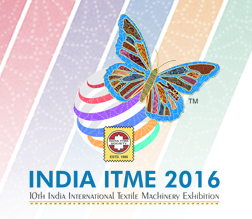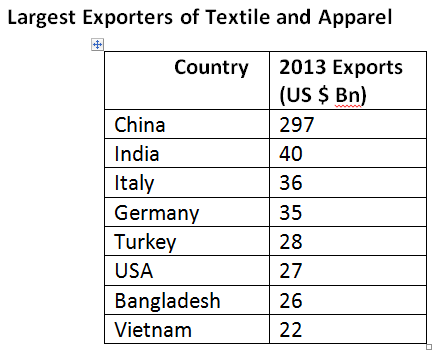 The 10th edition of India International Textile Machinery Exhibition 2016, the largest textile machinery and accessory exhibition in India is to be held from 3rd to 8th December 2016 at Bombay Exhibition Centre, Mumbai, India. The exhibition will be spread over 1,50,000 sq. mtrs, with participation from 93 countries and strength of 1000 exhibitors from across the globe. Exhibits will have 17 chapters spanning the textile segment from raw material to finished products, India ITME 2016 is the focal event for the textile and textile engineering industry in India and in the neighbouring region.
The 10th edition of India International Textile Machinery Exhibition 2016, the largest textile machinery and accessory exhibition in India is to be held from 3rd to 8th December 2016 at Bombay Exhibition Centre, Mumbai, India. The exhibition will be spread over 1,50,000 sq. mtrs, with participation from 93 countries and strength of 1000 exhibitors from across the globe. Exhibits will have 17 chapters spanning the textile segment from raw material to finished products, India ITME 2016 is the focal event for the textile and textile engineering industry in India and in the neighbouring region.
Global Textile machinery market is witnessing tremendous growth buoyed by growing demand of textile and apparel market. The major manufacturers of textile machinery are Germany, Italy, Switzerland, France and now China. One of the major trends in the global textile machinery market is the growing number of technological innovations.
In India, industry witnessed a growth of 8-10 per cent to Rs.22,000 crore in 2014 from Rs 20,000 crore in 2013. The size of India’s textile machinery industry is poised to double to Rs 45,000 crore in the next 7 years from the present Rs.22,000 crore in light of new projects and emphasis on setting up textile parks. The textile machinery manufacturing section is one of the important segments of the machinery manufacturing industry in India. This industry is nearly sixty years old and has more than 1000 machinery and component manufacturing units. Nearly 300 units produce complete machinery and the remaining produces various textile machinery components.
India’s textile and apparel industry (domestic + exports) is expected to grow from the current US $ 107 Bn. to US $ 223 Bn. by 2021. India is expected to be a leading textile producing country in the world by 2020.
Growing domestic demand and export market presence
The current domestic textile and apparel market is estimated to be US$ 68 Bn which is expected to grow at 12% CAGR to become US$ 154 Bn by 2020. Apparel constitutes the majority share of the market with value of US$ 50 Bn in 2013. Technical textile is a promising segment which is expected to grow fast at 18% CAGR.
In global exports of textile and apparel in 2013, India occupied second position in textile exports with 7% share but ranked sixth in apparel exports with 3.7% share. Overall, India held second position with 5.2% share of global exports. India has potential to increase its export share from present 5% to 8% by 2020.
Gradual diversification in apparel sourcing from China and compliance issues in Bangladesh
With increasing manufacturing costs in China and issues of social compliance in Bangladesh in the recent past, global buyers are looking towards sourcing destinations with costs lower than China and reliability higher than Bangladesh. China’s bulging domestic market will also need more attention than earlier from its textile and apparel manufacturers which will decelerate their export growth. The trend of buyers diversifying their sourcing albeit recent, is reflected in the fact that apparel exports growth of Cambodia, Vietnam and India has outgrown that of China and Bangladesh over the last 2 years. Even though exports from the competing countries will continue to grow, India stands to gain most in the long run with abundant availability of skilled manpower and a bigger and well integrated supply chain from fiber to finished product.
Investment worth US$ 100 Bn will be required in India by 2020, to cater to the growing market
The total domestic and export market of India will grow at a CAGR of 12% from present US$ 108 Bn to US$ 243 Bn in 2020 and investments worth US$ 100 Bn will be required for textile and apparel manufacturing in India to support this growth. Besides the capacity addition by existing players, we envisage entry of new entities, including major international players, in manufacturing of textile and apparel in India. Yarn manufacturing, weaving and processing are expected to attract-75% of the investments.
Advantage India
India has the potential to become manufacturing hub in the textile machinery, with abundance of skilled labour, low cost and natural resources available, provided sufficient focus is given on research and development in order to ensure modern and innovative technologies are developed in our country.
Except spinning, majority of the textile and apparel machinery demand of India is being fulfilled through imports, especially for investments in latest technology machines by large and organized mills. With a growing market and manufacturing scenario in India, textile machinery manufacturing in India will become more attractive and beneficial.
Following are some of the reasons:
India’s strong and improving manufacturing competitiveness
Over the years, India has established a strong and vertically integrated supply chain in textile and apparel manufacturing and has become one of the leading manufacturing destinations for textile and apparel in the world. India continues to be a competitive manufacturing destination for textiles as manufacturing costs in competing countries have increased.
Higher import cost of machinery due to currency devaluation
In the last couple of years, the Indian currency has depreciated significantly with respect to US$ while Yuan has appreciated. As almost 30% of total textile and apparel machinery is imported from China, this has caused a double impact. Under such a scenario, cost of importing machinery has also increased significantly. In coming years the trend is supposed to continue.
Costs in China are rising
There is no doubt in the fact that China has been a strong manufacturing base in recent years but the production costs in China are rising at a faster rate than other developing countries. Increase in manpower cost is the major factor which will impact cost of machinery manufacturing as well.
The labour wage cost index of China has almost doubled since 2002. The wages are further set to increase in coming time. In addition to it, the demographic shifts in China will limit the labour force in coming years due to ageing population. This will further increase wage rate and availability of skilled manpower for machinery production will also be an issue.
In contrast, India has very favorable demographics with a young population base. 60% of population in India falls in the age group of 15-59 years and 49% of population is less than 25 years. More number of people would be added in the productive age group of 20-60 years leading to abundant availability of skilled work force. The favorable demographics and relatively lower wage cost make India as one of the favorable destinations for manufacturing machinery.
Better Service & availability of Spare Parts
Apart from the cost advantage, manufacturing in India will give significant competitive advantage to the global machinery manufacturers in providing better service to buyers, especially in terms of spare parts. Import of spare parts has shown significant growth in value terms with 7% CAGR from 2005 to 2013 directing towards rising requirement in India.
Once machinery manufacturers decide to set up their unit in India, spare parts suppliers will also follow them. Even Indian companies will start manufacturing the machinery parts looking at the potential future demand size. Similar scenario has already been observed in automobile industry. Once spare parts availability becomes easier and quicker, it will also help in increasing market size of those machineries.
Export potential of textile machineries
Indian subcontinent is increasingly becoming dominant in textile and apparel manufacturing. India also has signed bilateral and multilateral treaties with different countries that have significant presence in textile manufacturing. As the cost of manufacturing in China is increasing, India is coming out to be the export hub for this region for different product categories including automobiles. Similar potential exist for textile machinery as well. In cost of manufacturing of spinning machineries, India is already one of the lowest if not least. Present textile machinery manufacturers are already exporting all over the world and the fresh investment in this sector will scale it up many times.
Indian Government supporting indigenous machinery manufacturing
Government of India has recently proposed a drive in favour of indigenous manufacturing and taking several policy decisions to make its “Make in India” campaign successful.
Following action points have been proposed by the expert committee in their draft ‘Vision, Strategy and Action Plan’ document prepared for Indian textile sector. All of those once implemented will motivate the textile and apparel manufacturers to purchase machineries made in India only.
Incentives under Scheme of Hire-Purchase and TUFS in specific segments should be made available only on indigenous machinery after period of three years. Import of second hand machinery should not be encouraged except in case of select machinery.
Basic customs duty of complete machinery should be at least 5% higher than that on raw material and components.
As per the union budget 2014-15, Indian Government has offered benefits for capital goods manufacturing in India with investment allowance at the rate of 15% to a manufacturing company that invests more than INR 25 crores in new plant and machinery.
India ITME Society, a 36 year old apex non-profit industry body has continuously strived through “ITME Series” to facilitate and push towards these goals. From 1980 onwards to ensure flow of latest technology and attract customized product launches for Indian market.
The 10th India ITME to be held in December 2016 will serve as an ideal convergence point for all exhibitors, buyers, agents and dealers from Asian, Middle East and European countries. India ITME 2016 is supported by Heavy Industries Department, Textile Ministry, NSIC and many other domestic and international organizers, making it one of the most anticipated exhibitions in the year of 2016. It is one of the premium events globally with 93 countries ensuring their presence as exhibitor and visitor.
India ITME-2016 is much anticipated and looked forward by Industry member, Technical Study Students Researches, Education of Textile and Textile Engineering Industry. It’s a catalyst to realize our future goals and growth target for Indian Textile and Textile Engineering Industry. This is a must participate, must visit, event, if you are in textile business.
